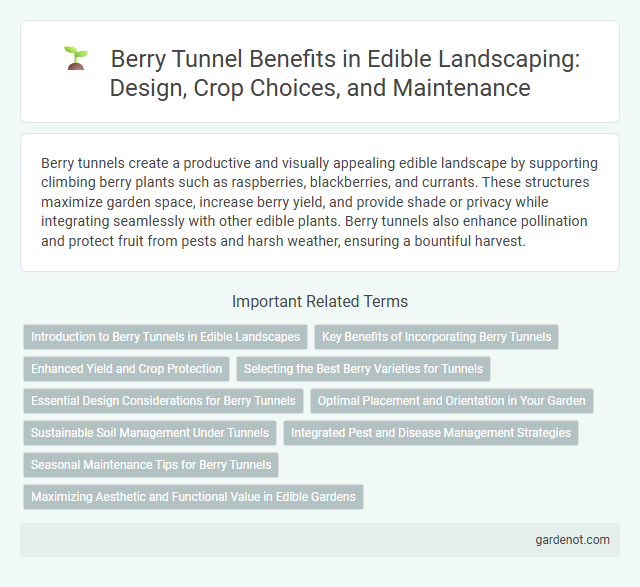Berry tunnels create a productive and visually appealing edible landscape by supporting climbing berry plants such as raspberries, blackberries, and currants. These structures maximize garden space, increase berry yield, and provide shade or privacy while integrating seamlessly with other edible plants. Berry tunnels also enhance pollination and protect fruit from pests and harsh weather, ensuring a bountiful harvest.
Introduction to Berry Tunnels in Edible Landscapes
Berry tunnels create vertical growing spaces for various berry species, maximizing yield in limited garden areas. These structures support plants like raspberries, blackberries, and blueberries, promoting healthy growth and easy harvest. Integrating berry tunnels into edible landscapes enhances biodiversity and provides visually appealing, productive garden features.
Key Benefits of Incorporating Berry Tunnels
Berry tunnels enhance edible landscapes by protecting fruit crops from pests, frost, and harsh weather, leading to higher yields and extended harvesting periods. They create a microclimate that boosts berry growth and ripening, ensuring consistent production throughout the season. In addition, berry tunnels reduce the need for chemical pesticides, promoting sustainable and organic gardening practices.
Enhanced Yield and Crop Protection
Berry tunnels optimize microclimate conditions, boosting fruit yield by maintaining consistent temperature and humidity levels. The protective structure reduces pest invasion and fungal diseases, ensuring healthier crops with minimal chemical intervention. Enhanced airflow and sunlight penetration under the tunnel promote faster berry maturation and higher-quality produce.
Selecting the Best Berry Varieties for Tunnels
Choosing the best berry varieties for edible landscape tunnels involves selecting plants that thrive in controlled environments with limited sunlight and airflow. Varieties such as raspberries, blackberries, and blueberries known for their disease resistance, high yield, and flavor quality perform exceptionally well in tunnel conditions. Prioritizing cultivars with compact growth habits and early fruiting cycles maximizes space efficiency and extends harvest periods within the tunnel.
Essential Design Considerations for Berry Tunnels
Berry tunnels require careful consideration of sunlight exposure, ensuring optimal growing conditions by positioning tunnels in areas with maximum light penetration. Selecting durable, UV-resistant materials for the frame and cover helps maintain structural integrity while protecting plants from pests and harsh weather. Proper ventilation and irrigation systems are crucial to prevent fungal diseases and provide consistent moisture for healthy berry growth.
Optimal Placement and Orientation in Your Garden
Positioning a berry tunnel in your garden requires selecting a site with full sun exposure for at least 6 to 8 hours daily to maximize fruit yield and improve berry sweetness. Orient the tunnel lengthwise along a north-south axis to ensure even sunlight distribution and reduce shading between rows. Proper drainage and air circulation around the structure also contribute to healthier plants and reduce disease risk.
Sustainable Soil Management Under Tunnels
Berry tunnels promote sustainable soil management by reducing erosion and preserving soil moisture through protective covering. The controlled microclimate under tunnels enhances organic matter decomposition and nutrient cycling, supporting soil fertility. Limited exposure to rainfall minimizes nutrient leaching, maintaining a balanced soil ecosystem essential for healthy berry production.
Integrated Pest and Disease Management Strategies
Berry tunnels enhance crop productivity by creating controlled environments that reduce pest and disease incidence in edible landscapes. Integrated Pest and Disease Management (IPDM) strategies within berry tunnels include regular monitoring, use of biological controls such as predatory insects, and application of organic fungicides to maintain plant health. These approaches decrease chemical dependency, support sustainable berry production, and improve fruit quality.
Seasonal Maintenance Tips for Berry Tunnels
Berry tunnel seasonal maintenance involves pruning spent canes and removing diseased foliage in late winter to encourage healthy growth and improve air circulation. Regular monitoring for pests such as aphids or spider mites throughout spring and summer helps maintain plant vigor. Mulching with organic matter retains soil moisture and regulates temperature, promoting optimal berry production during harvest seasons.
Maximizing Aesthetic and Functional Value in Edible Gardens
Berry tunnels enhance edible landscapes by providing vertical growth space for berry-producing plants like raspberries, blackberries, and blueberries, maximizing yield per square foot. These structures create visually appealing features with vibrant colors and textures, contributing both to garden aesthetics and biodiversity. Utilizing berry tunnels promotes efficient space use, easier harvesting, and natural pest management within sustainable garden designs.
Berry tunnel Infographic

 gardenot.com
gardenot.com